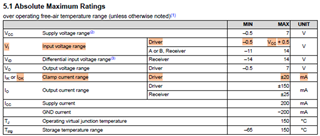Tool/software:
Hi all,
I have a question about the driver specifications of SN75C1167 related to PCN# 20240221006.1.
When a customer performed an in-circuit test (ICT), the following differences were found between SHE and RFAB products.
Voltage value of driver pins (pins 13 and 14):
SHE product: 0.5V
RFB product: 1.2V (OL displayed)
According to the following datasheet, these pins have ESD diodes implemented on both Vcc and GND.
If Vcc = 0V and DE of pin 12 is 0V, the voltage that would turn on the driver's ESD diode would be around +/-0.5V according to the datasheet specifications.
Is there a difference in the design of the driver's protection circuit between the two fabs?

Best regards,
Toshi

